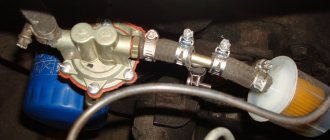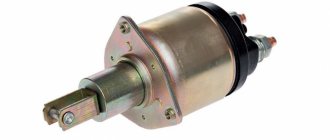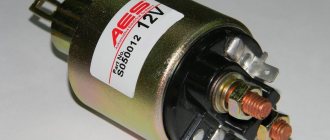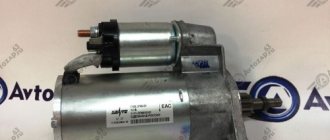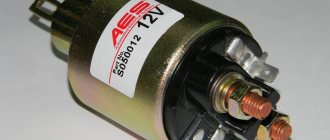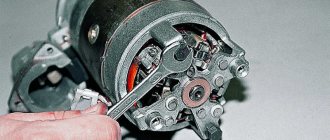Without starting the car engine, you will not be able to drive with the breeze. The starter is an extremely important part of any car with an internal combustion engine under the hood. This element turns the engine and starts it, so you can simply turn the key or press a button in the car and start driving.
Today we will tell you about the symptoms of a dying starter so that you understand when it fails.
A click is heard, but the engine does not start
Another symptom is the starter clicking when you try to start the engine. In this case, you can be sure that all electrical wires are in order. The malfunction probably occurred because the starter may have jammed or the relay may have broken. When the relay is bad, you can keep trying to start the car and it may work sooner or later. But this will only happen if you hear a click. If the starter is completely dead, you need to check the wires or change the relay.
Features of solenoid relay repair
This device controls the power supply to the starter armature. A relay breaks down mainly for three reasons:
- normal wear and tear of the product;
- problems with the windings: damaged wires, unnecessary contacts, breakdown to ground;
- carbon deposits on contact elements, also called “nickels”.
Often such problems occur due to water getting inside the solenoid relay. Therefore, if it breaks, the solution may be to disassemble it and then check the condition of the contact plates and windings. However, most often the faulty device is simply replaced with a new one.
Grinding noise from under the hood
In this case, the engine may or may not start. When you hear grinding noise, it means that the metal parts are not contacting each other the way the manufacturer intended. The problem may be a worn starter bendix that does not align with the engine flywheel.
If you continue to start the car, the Bendix gear will soon fail and the engine flywheel may also be damaged. Also, the starter may simply jam. So be sure to have your starter repaired as soon as possible after you hear the grinding noise.
First news of the problem
It is quite possible that the cause may be damaged wiring or a faulty ignition switch.
If when you turn the key in the ignition switch you hear a click and nothing else happens, then the reason for this may be a discharged battery or the starter itself.
I will not describe the device and principle of operation of the starter; full information on this topic can be studied in the picture below.
Problems with the starting system can be caused by poor maintenance or simply wear and tear. With many modern vehicles equipped with a start/stop button, the load on the starter and battery has increased significantly.
The starter is smoking, there is a smell of smoke
When the starter is about to die, it may also smoke. Wire connections may start to burn. The interior of the starter may also catch fire. If there is no open flame, it is not very dangerous. But trying to start your engine when you see smoke is a very bad idea.
Do not pour water on the starter if you see smoke. The best solution is to remove the wires from the battery terminals and call technical assistance. If the electrical part of the starter is broken, it may start to burn and you will have more trouble. Always check that the fire extinguisher is ready for use.
Burnt nickels
Carbon deposits on the contact plates of the retractor relay are a typical reason why the car sometimes does not start in the morning. In other words, when the nickels are burnt, the engine often does not start when cold.
It is interesting that individually the solenoid relay and the rest of the starter can work normally, but when assembled, instead of starting the engine, they only click. The functionality of nickels is restored approximately like this:
- the terminals on the starter relay are unsoldered;
- using a screwdriver, the relay housing is flared and opened;
- nickels are cleaned of carbon deposits;
- The jumper located on the rod is rotated and installed on the opposite side.
The starter continues to rotate after the engine starts
Another common starter problem is when the unit continues to turn after the engine has started. There is a noise and the starter itself is very hot even after a short drive. In this case, the culprit will most often be the starter relay or electrical connections.
It is recommended to turn off the engine and get help because driving a car with the starter spinning is a bad idea. You can break not only the starter, but also the engine flywheel.
Signs of a generator malfunction
Generator faults are not always easy to identify. Some of them (the so-called “floating” faults) are determined only on a special stand.
But if you notice that the headlights have become dimmer while the engine is running, and that extraneous noise interferes with the normal sound of the running engine or that the battery is quickly discharged, then it’s time to contact the experts. Because it is better to prevent a malfunction by repairing the generator in a timely manner than to ruin your day one day with an unexpected breakdown.
Recently, it has become very convenient to contact specialized companies whose specialization is the repair, maintenance and sale of starters and generators. Modern equipment, combined with qualified personnel and a large selection of spare parts, will allow you to eliminate any malfunction in just a few hours. And diagnostics with disassembly and analysis of the degree of wear of parts will help to quickly determine the degree of performance and carry out restoration work.
However, you can try to diagnose and eliminate some of the causes of generator malfunctions yourself.
If the battery in the car is not charging, then first of all you need to check the tension of the alternator belt - the belt should be tensioned without sagging. This, of course, can be done by eye, but it is better to use a dynamometer: if you pull the longest branch of the alternator belt with a force of 10 kgf, then it should bend no more than 10-15 mm.
On most machines, the tension of the alternator belt can be adjusted by loosening the nut securing the alternator housing to the adjusting bar and using a pry bar to move it away from the engine. After setting the required belt tension, tighten the generator mounting nut back.
If the tension of the generator belt is normal, then most likely the voltage regulator relay . On older cars it is a plastic box screwed to the front fender mudguard, but in modern cars the regulator is built directly into the generator itself.
To replace the relay-regulator in the generator, you must first unscrew the two mounting screws, disconnect the contacts, and then remove the regulator along with the brush assembly from the generator housing.
Check the slip rings: burnt ones should be cleaned with fine-grained sandpaper and wiped with a cloth soaked in solvent.
For the first time after installing a new regulator, the voltage may be slightly different from the nominal one. When the new generator brushes get used, everything will return to normal.
The starter continues to rotate after the engine is turned off
Sometimes you don't hear the starter turning after the engine starts. But when you park the car and turn off the engine, the noise continues to come from under the hood. This means that the starter turned on, started the engine and did not turn off. This can usually happen when the battery is almost empty. In some older starter designs, dead batteries can cause the starter electronics to fail and cause the unit to keep running.
You need to remove the wires from the battery terminals to stop the starter from turning. After a while, you can even try putting the wires back on and starting the car so you can go to a battery store or service station to have the battery replaced.
FAQ
What problems could the starter have?
Answer: All breakdowns are divided into electrical and mechanical. Electrical problems are associated with oxidation and burning of contacts, short circuits in windings, and broken cables.
The main 5 mechanical ones are as follows:
- Brush wear.
- Worn bearing bushings.
- Bendix failure.
- Bendix jamming in the screw thread on the anchor.
- A weak return spring or a slipped Bendix feed fork.
When to change the starter?
Answer: The starter is a unit that can be easily restored. They usually change it when repairs have already been carried out more than once, and the number of breakdowns becomes too frequent.
It's also time to buy a new one if:
- Cracks or chips have appeared on the body or covers.
- The rotor is jammed.
- The stator winding burned out.
Why doesn't the starter turn?
Answer: First of all, you need to check the battery - it is often to blame due to undercharging, insufficient electrolyte density, its leakage, and aging of the plates.
In the starter itself, the most common causes are:
- Oxidized terminals on the battery and connection to the starter.
- Short circuits in the stator or rotor windings.
- Damage to the solenoid relay.
- Jammed rotor.
- Excessive bushing wear.
- Critical brush wear.
How can you tell if the brushes are worn out?
Answer: Usually, when the brushes are worn out, the starter begins to work unstably, turning on after several attempts, and even after it starts working, it may suddenly stop working.
Sometimes you hear a crackling or slight knocking sound, and the starter smells a little like burning. The relay is activated, which is determined by a characteristic click, but the starter remains motionless.
How can you tell if the bushings are worn out?
Answer: With the starter removed, try moving the shaft on the toe. If there is wear, the shaft will move slightly from side to side.
Traces of the rotor touching the starter windings also appear. In particularly advanced cases, the stator and armature may burn out.
Sometimes the anchor jams and does not turn at all, or this can only be done with considerable effort.
Do not try to change the bushings yourself, this requires experience. Even the slightest misalignment will lead to the rotor being difficult to rotate and the starter will quickly burn out after repair.
The starter either turns or doesn't. Why is this happening?
Answer: Usually this behavior is associated with a malfunction of the solenoid relay, or more precisely, burnt contact brushes.
This is very easy to check. It is enough to close the starter contacts directly, for example, with a screwdriver.
Just remember to put the car in neutral, otherwise the car will move. The second possible reason is severe wear of the brushes.
Conclusion
The starter, depending on the model, has a resource of 70-200 thousand kilometers of the total mileage of the car, it depends on the condition of the engine and electrical system.
The resource can be significantly extended subject to periodic preventive maintenance and immediate servicing of the unit when the first signs of malfunction or abnormal operation appear.
What to do if the starter breaks down?
- You can try to start the car by asking someone to push it. But this is only possible with a manual transmission as you will need a clutch pedal.
- You can call technical assistance or a tow truck to deliver your car to a service station.
- You can replace the starter or its parts if you have the skills and tools to do so.
- You can have someone tow your car to the nearest service station.
The worst option is to continue driving unless you are sure it is safe for you and your car.
Bendix restoration
Perhaps the most loaded part of the starter is the bendix, which is structurally a unit of a gear and an overrunning clutch, also called a “freewheel”. This complex performs the function of transmitting torque from the armature to the flywheel installed on the engine.
The sequence of rotation transmission from the starter to the motor is as follows: rotor - freewheel - gear - flywheel. According to the principle of operation, the overrunning clutch is similar to the rear hub of a bicycle, but differs from the latter in that it is usually not subject to repair.
However, it is sometimes possible to restore the functionality of a faulty Bendix by “boiling” the device in heated starter oil. At the same time, the frozen old lubricant will be partially washed out and mixed with fresh one, which should add mobility to the rollers and improve their engaging properties. And the following signs may serve as a reason for this or some other repair of the gear-clutch unit :
- the starter buzzes, but the engine does not start;
- the armature rotates, but the flywheel does not;
- extraneous noise in the starter when starting the engine.
It is worth noting here that a creaking starter may be the result of a breakdown not only of the bendix, but also of the planetary gearbox. And the lack of interaction between the gear and the flywheel means improper operation of the guide lever.
Burnt contacts
In series: the battery, the power wire, the contact disk of the retractor and the brush assembly of the electric motor form a high-load circuit that passes through a current of 150 to 300 A. During operation, the entire circuit heats up noticeably, and especially the contact disk. If the car starts to have trouble starting and you have to turn the starter for a long time, the terminals of the power bolts melt, their surface is destroyed and stops conducting current.
Melted battery terminal
To check the conductivity, you need to remove the relay from the starter, take a multimeter, fix one of its probes on one power bolt, the second on the other. You need to measure the resistance by pressing your finger on the solenoid armature (closing the contact). A tone signal will mean that the “nickels” conduct current normally, numbers will mean that soot, oxide or damage has formed on them, interfering with conductivity.
Overrunning clutch jammed
If the starter makes sounds but does not turn the engine, you will need to remove it from the car for further diagnostics.
Overrunning starter clutch
You can check the clutch by turning the gear manually - in one direction and the other. If it spins freely in both directions, the clutch needs to be changed. The node is half-open and is located low enough, so it “collects” dirt. For prevention, you need to periodically clean it. Some car owners wash the clutch with a spray bottle, but this should not be done, nor should it be lubricated with grease. Otherwise, the part will jam due to contaminants adhering to the rod.
Problems with the anchor
Probably the most expensive starter malfunction in terms of repair is the breakdown of its armature. This problem can be recognized by the fact that this part rotates barely, as if the battery is discharged. And on a warm engine it may not turn at all.
Basically, difficulties with armature rotation arise due to wear of the sliding bearings on which this part is attached. The resulting play allows it to reach the stator, which increases the friction of the rotor against stationary parts. As a result, the efficiency of the entire starter decreases.
Further more. The armature plates move out of place, causing a short circuit. In such a situation, you can notice that the starter “absorbs” almost all the current coming from the battery. At the same time, the lights in the car go out and the audio system turns off; in extreme cases, the smell of burnt electrical wiring appears. If such a malfunction occurs, the armature must be replaced. Or better yet, the entire starter.
